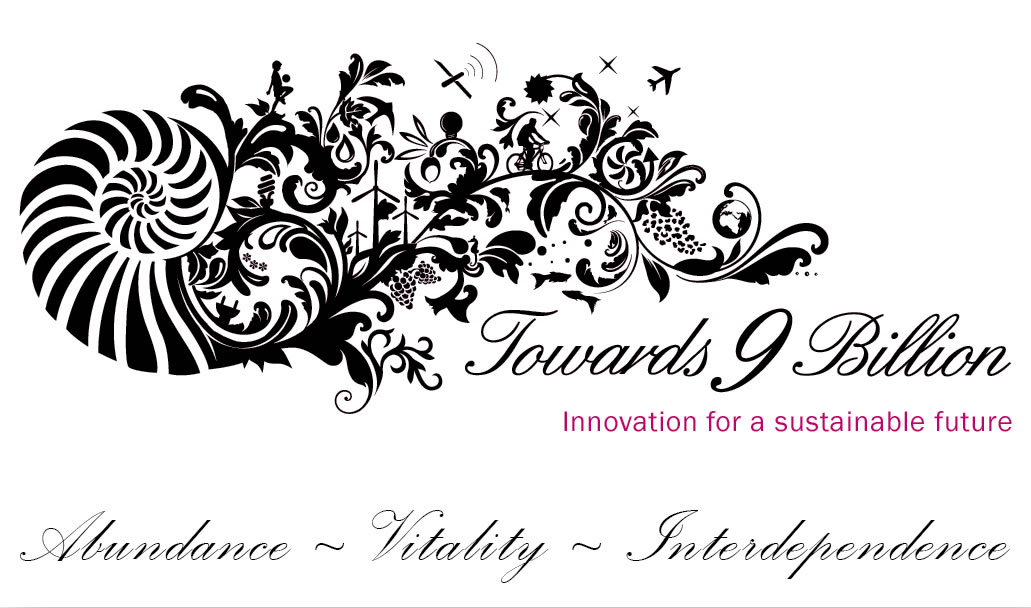Hack:
Towards 9 Billion: Infinite economy on a finite planet
A positive future vision where we can welcome 9 billion people to a planet with a flourishing economy and environment.
Utilising recognised market mechanisms, our ‘infinite economy’ hack recalibrates price to embed the value of life supporting ecosystems to deliver a vastly expanded global marketplace of 9 billion capable citizens.
“We are not going to be able to operate our Spaceship Earth successfully nor for much longer unless we see it as a whole spaceship and our fate as common. It has to be everybody or nobody.”
R. Buckminster Fuller
Current economic, financial and industrial models are accelerating humanity towards increasing ecological and financial instability and the likelihood of significant market, social and ecological failures.
The design and efficiency of current industrial processes, in terms of the use of energy and material consumption, are woefully inadequate to meet the demands of the majority of the Earth’s current population of 7 billion people. Huge pressures are placed upon food production, water availability and the climate. The continued availability of scarce resources threatens to limit existing models of manufacturing and therefore future market potential.
The human population is set to grow to more than 9 billion by 2050. What sort of world do we want them to come in to? One of scarce resources and extreme competition for the basic elements of survival, or one in which they are able to build stable and meaningful lives for themselves and their children?
Despite widespread recognition of these issues, the changes required to develop a sustainable future are not taking place at a rate or scale sufficient to meet the challenge. This is mainly due to economic, political and industrial complexity and the inertia of existing systems. It is also coupled with the problem of responding to major long-term challenges in the face of an unending stream of negative messages.
As a species, we are capable of conceptualising and achieving great things, moving mountains, feeding populations, greening deserts and making leaps of imagination and innovation. In addition, many technical, behavioural and social solutions already exist which could be used to deliver radically more sustainable production and consumption models.
A sustainable future requires coordinated will and intent together with an alignment of private and common interests.
This can be achieved by prioritising behaviour in markets, business and societies that recognises long term social and ecological implications and benefits. Long–term positive behaviours must be valued and suitably priced in our economic and financial systems.
The time has come to build a world where we can welcome 9 billion people rather than fear their arrival. A sustainable world of 9 billion capable citizens by 2050 is an ambitious vision and a powerful driver for the development of economies, businesses and societies. Such a world would offer almost unlimited market opportunities.
Capable citizens have the opportunities and abilities to make sovereign social, economic and personal choices, for themselves and their families. They have access to advanced education, are equitably rewarded for the use of their lives in other people’s employ and are able to raise children without fearing for their future. Capable of contributing to and accessing commercial and public services, they make conscious and informed decisions about the goods and services they buy.
Achieving such a vision has demands a range of social, technical and industrial pre-requisites.
Companies and markets would need to:
- Recognise social interdependence and prioritise personal and societal wellbeing.
- Preserve and enhance natural capital and ecosystem services.
- Focus on the sustainable use of scarce resources.
- Prioritise the use of abundant and renewable resources.
Such a world would also represent a market for business unparalleled through human history. It would align the interests of individuals, societies and business organically, through common self interest.
Today even the world’s largest companies only supply goods and services to less than half of the planet’s population. It is in the interest of businesses, citizens and societies as a whole to increase the number of economically active and capable people as this equates to greater productivity, larger markets and the creation of long-term value. It would also provide the growth of economic, social and natural capital.
Perhaps the most significant challenge to achieving this vision lies in the ability of the market to act in a strategic and coordinated manner. It must have both the incentive and capability to deliver the required strategic outcomes. To achieve this is it must meet the challenge of valuing activities and behavior which pay off over the long term. Evolving some of the fundamental mechanisms of market economics and capitalism would allow sustainable decisions and behaviors to be inherently valued and prioritised rather than considered as an afterthought.
How this would be achieved
This would be achieved through the following two sets of activities.
1. A shared strategic goal for markets
Rather than a real coordinated mass-effect of capitalism, Adam Smith's "Invisible Hand" is instead a post hoc rationalisation of the sum of a multitude of individually motivated market actions, not the actions of individuals subscribing to a shared grand plan - markets lack shared strategic intent.
A lack of coordinated intent makes the delivery of strategic outcomes difficult and to an extent explains why global objectives such as the Millennium Development Goals and other international accords are difficult to achieve in practice. They exist outside or in addition to the daily priorities of capitalism rather than as an integral part.
Towards 9 Billion is designed to address this issue through introducing a clear and economically meaningful purpose to market and business activity, the achievement of a vastly larger and more sustainable market. A market that also provides greater well-being and long-term common good.
A shared vision provides a goal for aspiration and also allows clear judgments to be made about whether market and company behavior is likely to achieve that vision or undermine it.
2. Hacking the price function
Towards 9 Billion also requires simple but fundamental changes to the irreducible heart of economics – the price function. All economic behaviour flows from the price function, the ability to generate a price for a good or service which allows it to be bought, sold and traded. At present the price function is too one dimensional, it reduces reality to supply and demand and fails to adequately internalise long-term human or ecological value.
A radical change in this critical mechanism would allow ecological and social sustainability to become a natural outcome of economic behaviour. We therefore propose to “hack the price function” by placing three concepts at the heart of the price equation to yield innately sustainable outcomes.
Instead of deriving price simply from supply and demand we suggest it should also be based upon:
- Abundance rather than scarcity - scarce things are only of marginal utility in a world of 9 billion capable citizens – either natural (e.g. biologically based) or managed (e.g. through closed loop stewardship) abundance is inherently more valuable in this context.
- Natural vitality – making use of the planet’s natural restorative and productive abilities and learning from and utilising natural production techniques as the basis for our technological and industrial models.
- Interdependence – nothing happens in our modern world without the involvement of others. We need to recognise and balance this interdependence so that our quality of life is not bought at the cost of someone else’s and that our quality of life is not at risk if others we depend upon decide to withdraw their subsidy.
The development of this vision, and the evolution of the price function, would be a major step towards the integration of environmental and social costs. It would provide a significant drive towards a sustainable world, delivering significant reductions in systemic risk and market failures.
In addition, motivations of businesses would change towards a positive sum view. It would become an economic benefit to design industrial production activities around resources which are more likely to have longevity of supply and which enhance, work alongside, utilise or borrow from naturally productive processes and capacity.
In the social dimension, valuing and maintaining interdependence would result in increasing global equity and help ensure a more even global spread of economic development and increased quality of life.
In summary, companies and markets would, as a natural aspect of market capitalism:
- consider the longevity and safety of supply of the resources they depend upon;
- act to value and enhance the quality and diversity of the natural capital upon which human life depends, and:
- prioritise mutual equity in relationships with suppliers, customers and other stakeholders.
Towards 9 billion provides a vision and approach applicable to the economic system but equally to individual companies and organisations.
Companies that interpret social and environmental trends, develop strategies to reduce risk and capitalise upon the new market opportunities, are likely to be more “future proof” than companies which wait for leadership to come from governments and bureaucrats.
For a company, integrating the vision of 9 billion capable citizens into strategic intent would provide a clear positive social and economic goal and stimulate innovative and creative thinking. For a company to deliver the vision staff and leadership would address the following strategic questions:
- “How will our actions either contribute to or undermine a world of 9 billion capable citizens?”
- “How can we make our company fit for a future of 9 billion capable citizens?”
- “What role will our company play in building a world of 9 billion capable citizens?”
Factoring in the concepts of abundance, vitality and interdependence into decision making will also have clear benefits in terms of sustainability. The following questions can be asked to assess any given action:
- Does it depend upon a resource that is innately scarce or abundant?
- Will it promote or undermine natural vitality and the quality of natural systems?
- Does it value the people relied upon to deliver this product or service and is the action likely to make that dependence more or less stable?
Companies can create and participate in the infinite economy now without waiting for an external lead. Many companies are already developing focussed sustainability strategies and products embedding environmental and social issues and aimed at building long term economic value.
There are many good reasons for following this lead; focusing on strategic vulnerabilities and dependencies, developing and ensuring future markets, hedging against volatility and identifying, avoiding and mitigating sources of systemic risk. All these signal inherently sound business practice and lead to inclusive long-term value creation.
Companies embracing the ‘infinite economy’ with vision, creativity and innovation are likely to be reaping the rewards sooner and longer than those which ignore the way the world is turning.
Joss Tantram, Partner Corporate Sustainability Terrafiniti LLP.
Dr Dominic Tantram, Partner Environmental Sustainability Terrafiniti LLP.




You need to register in order to submit a comment.